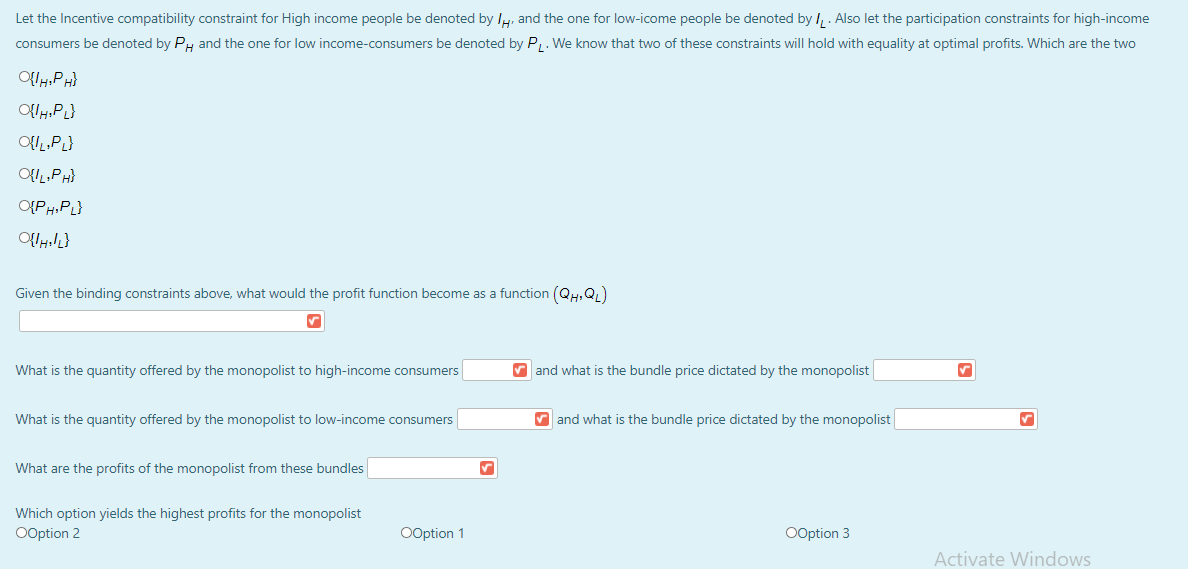Consider a monopolist who faces 17 identical high-income consumers, each with an inverse demand PH=-Q+12 and 92 identical low-income consumers, each with an inverse demand P1 =-Q+5 The monopolist has the following cost function C(Q)=2.Q Let Wy(Q) denote the willingness to pay of a high-income consumer for Q units and let W, (Q) denote the willingness to pay of a low-income consumer for Q units What is WA(Q) as function of Q= What is W_ (Q) as a function of Q= OPTION 1: Suppose the monopolist offers only one type of package (Q, V)(buy Q units for a total price of V) which will be bought by high-income consumers. What is the profit function of the monopolist What is the quantity that the monopolist will choose in the bundle What is the price of the bundle What are the profits of the monopolist OPTION 2: Suppose the monopolist offers only one type of package (Q, V)(buy Q units for a total price of V) which will be bought by both low and high income consumers. What is the profit function of the monopolist Activate Wind What is the quantity that the monopolist will choose in the bundle Go to Settings to a What is the price of the bundleWhat is the participation constraint for the high-income people What is the objective function of the monopolist as a function of VH, VL, QH. Q, Let the Incentive compatibility constraint for High income people be denoted by /4. and the one for low-icome people be denoted by /2 . Also let the participation constraints for high-income consumers be denoted by P; and the one for low income-consumers be denoted by PL- We know that two of these constraints will hold with equality at optimal profits. Which are the two OUH, FLY OUL FD O(F H PD) Given the binding constraints above, what would the profit function become as a function (QH, Q1) V What is the quantity offered by the monopolist to high-income consumers and what is the bundle price dictated by the monopolist What is the quantity offered by the monopolist to low-income consumers and what is the bundle price dictated by the monopolist v What are the profits of the monopolist from these bundles v Which option yields the highest profits for the monopolist OOption 2 OOption 1 OOption 3 Now suppose that the monopolist was mistaken in the number of low-end consumers and specifically the number of low end consumers was not estimated correctly. In order for the monopolist to still choose the same option as above, what should the proportion of low- income to high income consumers be greater than V Finally, if the proportion of low to high income consumers is smaller than above, which Option will maximizes the monopolist's profits OOption 1 OOption 3 OOption 2What are the profits of the monopolist OPTION 3: Suppose the monopolist offers two types of packages (QH; VA) (buy Q, units for a total price of VH) for high income consumers and package (QL: VL) (buy Q, units for a total price of VL) for low income consumers What is the incentive compatibility constraint for the high-income people Call this /H What is the incentive compatibility constraint for the high-income people What is the participation constraint for the high-income people What is the participation constraint for the high-income people What is the objective function of the monopolist as a function of VH, VL, QH, Q_Let the Incentive compatibility constraint for High income people be denoted by /,y, and the one for low-icome people be denoted by / . Also let the participation constraints for high-income consumers be denoted by Py and the one for low income-consumers be denoted by PL. We know that two of these constraints will hold with equality at optimal profits. Which are the two Of/ H: PH) OIL, PHY Of P H , PL) Given the binding constraints above, what would the profit function become as a function (QH, Q1) What is the quantity offered by the monopolist to high-income consumers and what is the bundle price dictated by the monopolist What is the quantity offered by the monopolist to low-income consumers and what is the bundle price dictated by the monopolist What are the profits of the monopolist from these bundles Which option yields the highest profits for the monopolist OOption 2 OOption 1 OOption 3 Activate WindowsWhich option yields the highest profits for the monopolist OOption 2 OOption 1 OOption 3 Now suppose that the monopolist was mistaken in the number of low-end consumers and specifically the number of low end consumers was not estimated correctly. In order for the monopolist to still choose the same option as above, what should the proportion of low-income to high income consumers be greater than Finally, if the proportion of low to high income consumers is smaller than above, which Option will maximizes the monopolist's profits OOption 1 OOption 3 OOption 2











